

Teaching Boys to Care: A Mental Health Documentary. Ghosts in the classroom: insights into passive disengagement in the middle years. Students who passively disengage from classroom learning usually go unnoticed by their teachers.

How to Help Teenage Girls Reframe Anxiety and Strengthen Resilience. Change and stress go hand in hand -- even if a change is positive. Teenagers' lives are filled with change: Their bodies and brains are transforming, they usually switch schools at least once between grades 5 and 12, their academic workload is increasing, and social relationships are constantly evolving. The anxiety that comes with stretching to face these and other challenges is part of how humans develop strength, said Damour. When she talks with teenage girls, she uses the metaphor of exercise: To develop physical strength, you have to slowly push your levels of physical endurance, building up strength through resistance training. Similarly, said Damour, “you should see [a challenge] as an extraordinary weight training program for your mind.
Students Learn From People They Love The New York Times. To Ignite Adolescent Brains School Must be about THEM. Tcc-ctc. Edutopia - A common studying technique—highlighting... The Teenage Brain Is Wired to Learn—So Make Sure Your Students Know It. Adolescence is an exciting time as teenagers become increasingly independent, begin to look forward to their lives beyond high school, and undergo many physical, emotional, and cognitive changes.
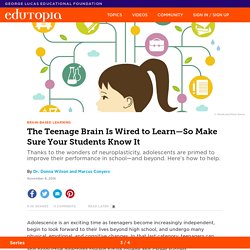
In that last category, teenagers can learn to take charge of their developing brains and steer their thinking in positive and productive directions toward future college and career success. The brain’s prefrontal cortex, which functions as the control center for executive functions such as planning, goal setting, decision making, and problem solving, undergoes significant changes during the teenage years.
In an NPR interview, Laurence Steinberg, author of Age of Opportunity: Lessons From the New Science of Adolescence, notes that ages 12 to 25 are a period of extraordinary neuroplasticity. They have the capacity to become functionally smarter. By their early teens, many youths have already formed an image of themselves as intellectually capable—or not. Tools for Self-Directed Learning. The disengaged school kids finding new paths to learning. By John Stewart and Brigid Andersen Updated Last month the Grattan Institute found 40 per cent of Australian high school students were disengaged from classroom learning.
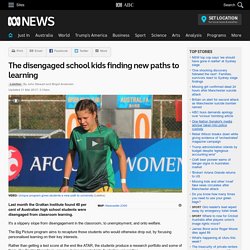
20 Strategies for Motivating Reluctant Learners. Kathy Perez has decades of experience as a classroom educator, with training in special education and teaching English language learners.
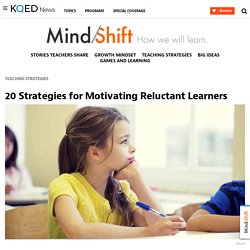
She also has a dynamic style. Sitting through her workshop presentation was like being a student in her classroom. She presents on how to make the classroom engaging and motivating to all students, even the most reluctant learners, while modeling for her audience exactly how she would do it. The experience is a bit jarring because it’s so different from the lectures that dominate big education conferences, but it’s also refreshing and way more fun. Perez says when students are engaged, predicting answers, talking with one another and sharing with the class in ways that follow safe routines and practices, they not only achieve more but they also act out less. “If we don’t have their attention, what’s the point?” She’s a big proponent of brain breaks and getting kids moving around frequently during the day. Tips & Tools to Improve Student Notetaking Skills.
I am a scribbler and a note-taker.
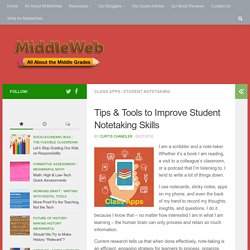
Whether it’s a book I am reading, a visit to a colleague’s classroom, or a podcast that I’m listening to, I tend to write a lot of things down. How Relearning Old Concepts Alongside New Ones Makes It All Stick. By Samara Freemark and Stephen Smith, American RadioWorks UCLA researcher Dick Schmidt gazes across the driving range at a line of golfers trying to improve their game.

It’s a breezy day at the Westchester Golf Course and there’s a relentless roar of jet traffic from the nearby Los Angeles airport. Schmidt is a retired professor of psychology at UCLA, and an authority on how humans learn and develop motor skills. As Schmidt watches the golfers practice the same swing with the same clubs, over and over, he chuckles. 4 Strategies for Teaching Students How to Revise. I'm a fan of the writing workshop.
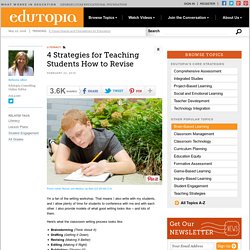
That means I also write with my students, and I allow plenty of time for students to conference with me and with each other. I also provide models of what good writing looks like -- and lots of them. Here's How Study Breaks Boost Learning. Via Huffington Post Students in school are rarely given opportunities to rest and reflect on the knowledge they’ve acquired, but a new study suggests that giving the mind a little targeted downtime could be a highly effective way to boost learning.
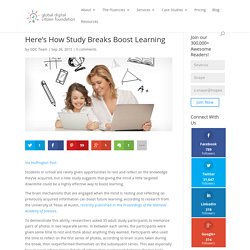
The brain mechanisms that are engaged when the mind is resting and reflecting on previously acquired information can boost future learning, according to research from the University of Texas at Austin, recently published in the Proceedings of the National Academy of Sciences. To demonstrate this ability, researchers asked 35 adult study participants to memorize pairs of photos in two separate series. In between each series, the participants were given some time to rest and think about anything they wanted.
25 Things Skilled Learners Do Differently. Imagine for a moment that all human beings had the same IQ, but that some of us knew how to tap into it better than others.
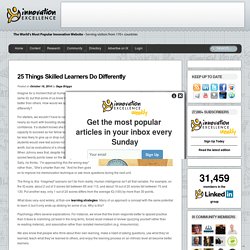
How would we approach education differently? For starters, we wouldn’t have to concern ourselves nearly as much with boosting students’ academic confidence. If a student knows she has the same capacity to succeed as her fellow learners, then she’ll be less likely to give up or drop out. In a similar vein, students would view test scores not as measures of self worth, but as evaluations of a chosen learning strategy. When Johnny sees that, despite his best efforts, he scored twenty points lower on the biology exam than Sally, he thinks, “I’m approaching this the wrong way” rather than, “She’s smarter than me.” The thing is, this “imagined” scenario isn’t far from reality.
Good Study Habits. Students are rarely taught how to study successfully and effectively.

Yet research shows that developing good study habits and adopting proven study techniques and methods can be the difference between doing well and badly in exams. Effective study strategies can also give students an edge that pushes them a grade higher. The 10 Best Evidence-Based Study Tips. Advice to HSC students about examinations. Advice for HSC students about examinations This document provides important advice about the HSC examinations. Each year there are some students whose results are not as good as they could be because of simple, easily avoidable factors. For example, students who answer questions from more than one option, write responses in the wrong place, or submit a project that doesn’t meet technical requirements can disadvantage themselves.
Strategies for Helping Students Motivate Themselves. Editor's Note: This piece was adapted from Building a Community of Self-Motivated Learners: Strategies to Help Students Thrive in School and Beyond by Larry Ferlazzo, available March 21, 2015 from Routledge. My previous post reviewed research on extrinsic and intrinsic motivation, and described the four qualities that have been identified as critical to helping students motivate themselves: autonomy, competence, relatedness, and relevance.
In this post, I'll discuss practical classroom strategies to reinforce each of these four qualities. Autonomy Providing students with freedom of choice is one strategy for promoting learner autonomy. Educators commonly view this idea of choice through the lens of organizational and procedural choice. 60 Powerful Social Issue Ads That'll Make You Stop And Think. Amy Cuddy: Your body language shapes who you are. 9 Strategies to improve your students thinking skills. It is a common complaint that our students lack the ability to think for themselves. Maybe we should look at whether they have had the opportunity to learn thinking. We learn most things by observing with our senses, imitating what we have seen/heard and then modifying what we have learned to fit into our values, beliefs or abilities. The problem with thinking is that it is largely invisible.
7 Skills students need for their future. Energy and Calm: Brain Breaks and Focused-Attention Practices. When presented with new material, standards, and complicated topics, we need to be focused and calm as we approach our assignments. We can use brain breaks and focused-attention practices to positively impact our emotional states and learning. They refocus our neural circuitry with either stimulating or quieting practices that generate increased activity in the prefrontal cortex, where problem solving and emotional regulation occur.
Brain Breaks. 10 Great Homework Help Websites for Students. 15 Must Have Google Lessons Plans to Teach Students Effective Search Skills. April , 2014 Google is one of the primary search engines students turn to when doing their research. On the face of it, searching Google seems as simple as typing in a search query and waiting for returned results. Google's Schmidt: Teens' mistakes will never go away. Excellent Video On Having A “Growth Mindset. Aissw2013. Public Critique. Eberopolis: Assessing Student Work. Having just temporarily recovered from working on report cards, I thought I'd share a little about a technique I use for grading student work. Replacing Teachers with Emotion. Image credit: iStockphoto Teachers mean well. By teachers, I mean you. You mean well. RSA Animate - Drive: The surprising truth about what motivates us.
26 Questions Every Student Should Be Able To Answer - 26 Questions Every Student Should Be Able To Answer by Terry Heick These questions are more about the student than you, your classroom, or education. What every student should know starts with themselves and moves outwards to your content area: self knowledge–> content knowledge.
As an educator, your job is lead students to understanding, but student self-awareness and self-knowledge should precede that. Benefits of SEL. There is a growing awareness in the U.S. among educators and policymakers about the importance of social and emotional development for successful student performance in preschool and elementary school. Teaching Students the ABCs of Resilience. Two Letters That All Students Should Receive. 5 Things Students Expect From Their Teachers.
5 Learning Strategies That Make Students Curious.